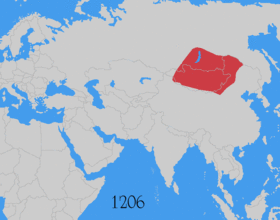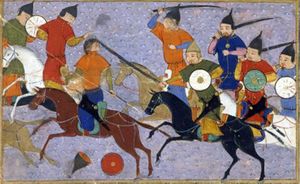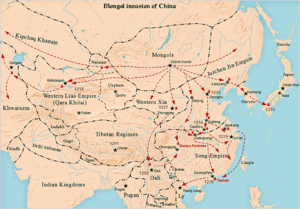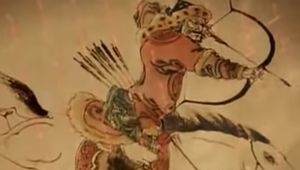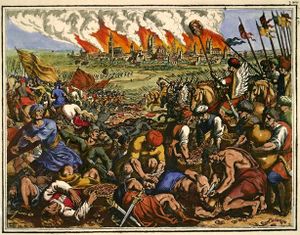الغزوات والفتوحات المنغولية
| ||||||||||||
الغزوات والفتوحات المنغولية، وقعت على مدار القرن الثالث عشر، وأسفرت عن تأسيس الامبراطورية المنغولية الشاسعة، والتي، بحلول 1300، غطت معظم آسيا وشرق أوروپا. يرى المؤرخون أن الدمار في عهد الامبراطورية المنغولية كان من أعتى النزاعات في تاريخ البشرية. بالإضافة إلى ذلك، فقد جلبت التجريدات المنغولية معها الطاعون الدملي، الذي انتشر في معظم آسيا وأوروپا الذي ساعد على إحداث خسائر فادحة في الأرواح في الموت الأسود بالقرن الرابع عشر.[1][need quotation to verify][2][3][need quotation to verify][4]
تطورت الإمبراطورية المغولية في القرن الثالث عشر من خلال سلسلة من الغزوات والاجتياحات في جميع أنحاء آسيا، حتى وصلت إلى شرق أوروپا بحلول أربعينيات القرن الثالث عشر. على نقيض الإمبراطوريات اللاحقة مثل الامبراطورية البريطانية، والتي يمكن تعريفها "كامبراطوريات بحرية"، كانت الامبراطورية المنغولية امبراطورية برية، tellurocracy،[5] يغذيها العشب الذي يدعم الفرسان والماشية المنغولية.[6] وهكذا فإن معظم غالزو والنهب المنغولي حدث خلال المواسم الأكثر دفئاً، عندما كان هناك العشب الكافي لقطعان الماشية.[6]
استمرت الغارات التترية والمنغولية على الدويلات الروسية إلى ما بعد بداية تبعثر الامبراطورية المنغولية ح. 1260. في أماكن أخرى، استمرت المكاسب المنغولية على الأرض في الصين حتى القرن 14 في عهد أسرة يوان، بينما استمرت في فارس حتى القرن 15 في عهد الامبراطورية التيمورية. في الهند، استمرت دولة المنغول حتى القرن 19 من خلال الامبراطورية المنغولية.
Overview
The Mongol Empire developed in the course of the 13th century through a series of victorious campaigns throughout Eurasia. At its height, it stretched from the Pacific to Central Europe. In contrast with later "empires of the sea" such as the European colonial powers, the Mongol Empire was a land power, fueled by the grass-foraging Mongol cavalry and cattle.[أ] Thus most Mongol conquest and plundering took place during the warmer seasons, when there was sufficient grazing for their herds.[6] The rise of the Mongols was preceded by 15 years of wet and warm weather conditions from 1211 to 1225 that allowed favourable conditions for the breeding of horses, which greatly assisted their expansion.[7]
As the Mongol Empire began to fragment from 1260, conflict between the Mongols and Eastern European polities continued for centuries. Mongols continued to rule China into the 14th century under the Yuan dynasty, while Mongol rule in Persia persisted into the 15th century under the Timurid Empire. In India, the later Mughal Empire survived into the 19th century.
History and outcomes
آسيا الوسطى
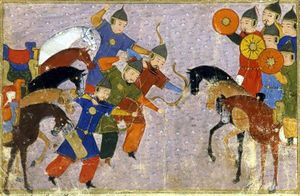
Genghis Khan forged the initial Mongol Empire in Central Asia, starting with the unification of the nomadic tribes Merkits, Tatars, Keraites, Turks, Naimans and Mongols. The Buddhist Uighurs of Qocho surrendered and joined the empire. He then continued expansion via conquest of the Qara Khitai[8] and of the Khwarazmian Empire.
Large areas of Islamic Central Asia and northeastern Persia were seriously depopulated,[9] as every city or town that resisted the Mongols was destroyed. Each soldier was given a quota of enemies to execute according to circumstances. For example, after the conquest of Urgench, each Mongol warrior – in an army of perhaps two tumens (20,000 troops) – was required to execute 24 people, or nearly half a million people per said army.[10]
Against the Alans and the Cumans (Kipchaks), the Mongols used divide-and-conquer tactics by first warning the Cumans to end their support of the Alans, whom they then defeated,[11] before rounding on the Cumans.[12] The Alans were recruited into the Mongol forces and known as the Asud, with one unit called "Right Alan Guard" that was combined with "recently surrendered" soldiers. Mongols and Chinese soldiers stationed in the area of the former state of Qocho and in Besh Balikh established a Chinese military colony led by Chinese general Qi Kongzhi.[13]
During the Mongol attack on the Middle East ruled by the Mamluk Sultanate, most of the Mamluk military was composed of Kipchaks and the Golden Horde's supply of Kipchak fighters replenished the Mamluk armies and helped them fight off the Mongols.[11]
Hungary became a refuge for fleeing Cumans.[14]
The decentralized, stateless Kipchaks only converted to Islam after the Mongol conquest, unlike the centralized Karakhanid entity comprising the Yaghma, Qarluqs, and Oghuz who converted earlier to world religions.[15]
The Mongol conquest of the Kipchaks led to a merged society with a Mongol ruling class over a Kipchak-speaking populace which came to be known as Tatar, and which eventually absorbed Armenians, Italians, Greeks, and Crimean Goths in Crimea, the origin of the current Crimean Tatars.[16]
غرب آسيا

The Mongols conquered, by battle or voluntary surrender, the areas of present-day Iran, Iraq, the Caucasus, and parts of Syria and Turkey, with further Mongol raids reaching southwards into Palestine as far as Gaza in 1260 and 1300. The major battles were the siege of Baghdad, when the Mongols sacked the city which had been the center of Islamic power for 500 years, and the Battle of Ain Jalut in 1260 in south-eastern Galilee, when the Muslim Bahri Mamluks were able to defeat the Mongols and decisively halt their advance for the first time. One thousand northern Chinese engineer squads accompanied the Mongol Hulagu Khan during his conquest of the Middle East.[ب]
شرق آسيا
Genghis Khan and his descendants launched progressive invasions of China, subjugating the Western Xia in 1209 before destroying them in 1227, defeating the Jin dynasty in 1234 and defeating the Song dynasty in 1279. They made the Kingdom of Dali into a vassal state in 1253 after the Dali King Duan Xingzhi defected to the Mongols and helped them conquer the rest of Yunnan, forced Korea to capitulate through nine invasions, but failed in their attempts to invade Japan, their fleets scattered by kamikaze storms.
The Mongols' greatest triumph was when Kublai Khan established the Yuan dynasty in China in 1271. The dynasty created a "Han Army" (漢軍) out of defected Jin troops and an army of defected Song troops called the "Newly Submitted Army" (新附軍).[18]
The Mongol force which invaded southern China was far greater than the force they sent to invade the Middle East in 1256.[19]
The Yuan dynasty established the top-level government agency Bureau of Buddhist and Tibetan Affairs to govern Tibet, which was conquered by the Mongols and put under Yuan rule. The Mongols also invaded Sakhalin Island between 1264 and 1308. Likewise, Korea (Goryeo) became a semi-autonomous vassal state of the Yuan dynasty for about 80 years.
شمال آسيا
By 1206, Genghis Khan had conquered all Mongol and Turkic tribes in Mongolia and southern Siberia. In 1207 his eldest son Jochi subjugated the Siberian forest people, the Uriankhai, the Oirats, Barga, Khakas, Buryats, Tuvans, Khori-Tumed, and Yenisei Kyrgyz.[20] He then organized the Siberians into three tumens. Genghis Khan gave the Telengit and Tolos along the Irtysh River to an old companion, Qorchi. While the Barga, Tumed, Buriats, Khori, Keshmiti, and Bashkirs were organized in separate thousands, the Telengit, Tolos, Oirats and Yenisei Kirghiz were numbered into the regular tumens[21] Genghis created a settlement of Chinese craftsmen and farmers at Kem-kemchik after the first phase of the Mongol conquest of the Jin dynasty. The Great Khans favored gyrfalcons, furs, women, and Kyrgyz horses for tribute.
Western Siberia came under the Golden Horde.[22] The descendants of Orda Khan, the eldest son of Jochi, directly ruled the area. In the swamps of western Siberia, dog sled Yam stations were set up to facilitate collection of tribute.
In 1270, Kublai Khan sent a Chinese official, with a new batch of settlers, to serve as judge of the Kyrgyz and Tuvan basin areas (益蘭州 and 謙州).[23] Ogedei's grandson Kaidu occupied portions of Central Siberia from 1275 on. The Yuan dynasty army under Kublai's Kipchak general Tutugh reoccupied the Kyrgyz lands in 1293. From then on the Yuan dynasty controlled large portions of Central and Eastern Siberia.[24]
شرق ووسط أوروپا
The Mongols invaded and destroyed Volga Bulgaria and Kievan Rus', before invading Poland, Hungary, Bulgaria, and other territories. Over the course of three years (1237–1240), the Mongols razed all the major cities of Russia with the exceptions of Novgorod and Pskov.[25]
Giovanni da Pian del Carpine, the Pope's envoy to the Mongol Great Khan, traveled through Kiev in February 1246 and wrote:
They [the Mongols] attacked Russia, where they made great havoc, destroying cities and fortresses and slaughtering men; and they laid siege to Kiev, the capital of Russia; after they had besieged the city for a long time, they took it and put the inhabitants to death. When we were journeying through that land we came across countless skulls and bones of dead men lying about on the ground. Kiev had been a very large and thickly populated town, but now it has been reduced almost to nothing, for there are at the present time scarce two hundred houses there and the inhabitants are kept in complete slavery.[26]
The Mongol invasions displaced populations on a scale never seen before in central Asia or eastern Europe. Word of the Mongol hordes' approach spread terror and panic.[27] The violent character of the invasions acted as a catalyst for further violence between Europe's elites and sparked additional conflicts. The increase in violence in the affected eastern European regions correlates with a decrease in the elite's numerical skills, and has been postulated as a root of the Great Divergence.[28]
جنوب آسيا
From 1221 to 1327, the Mongol Empire launched several invasions into the Indian subcontinent. The Mongols occupied parts of NW South Asia for decades. However, they failed to penetrate past the outskirts of Delhi and were repelled from the interior of India. Centuries later, the Mughals, whose founder Babur had Mongol roots, established their own empire in India.
جنوب شرق آسيا
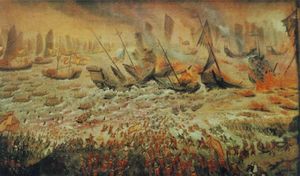
Kublai Khan's Yuan dynasty invaded Burma between 1277 and 1287, resulting in the capitulation and disintegration of the Pagan Kingdom. However, the invasion of 1301 was repulsed by the Burmese Myinsaing Kingdom. The Mongol invasions of Vietnam (Đại Việt) and Java resulted in defeat for the Mongols, although much of Southeast Asia agreed to pay tribute to avoid further bloodshed.[29][30][31][32][33][34]
The Mongol invasions played an indirect role in the establishment of major Tai states in the region by recently migrated Tais, who originally came from Southern China, in the early centuries of the second millennium.[35] Major Tai states such as Lan Na, Sukhothai, and Lan Xang appeared around this time.
عدد القتلى
Due to the lack of contemporary records, estimates of the violence associated with the Mongol conquests vary considerably.[36] Not including the mortality from the Plague in Europe, West Asia, or China[37] it is possible that between 20 and 57 million people were killed between 1206 and 1405 during the various campaigns of Genghis Khan, Kublai Khan, and Timur.[38][39][40] The havoc included battles, sieges,[41] early biological warfare,[42] and massacres.[43][44]
خط زمني
- الغزو المنغولي لشيا الغربية 1205، 1207، 1208، 1209–1210، 1225–1227
- غزو صربيا 1207
- غزو أسرة جين 1211-1234
- الغزو المنغولي 1216-1220
- غزو قپچاق 1220-1224
- الغزوات المنغولية للهند 1222-1327
- الغزو المنغولي لبلغاريا ڤولگا 1223-1236
- الغزو المنغولي لكوريا 1231-1259
- غزو أسرة سونگ 1235-1279
- الغزو المنغولي لأوروپا 1222، 1236-1242
- الغزو المنغولي لروسء 1236-1242
- غزو شرق وشمال روسء 1237-1238
- غزو شمال القوقاز 1238-1239
- غزو دولة القومان وآلانيا 1238-1240
- غزو 1241 لپولندا وبوهميا
- غزو المجر 1241
- غزو النمسا وشمال شرق إيطاليا 1241
- غزو كرواتيا 1241-1242
- غزو صربيا وبلغاريا 1242
- غزو التبت 1240-1241
- غزو الأناضول 1241–1244
- 1244-1265 غزو مملكة دالي
- غزو فارس، سوريا وبلاد الرافدين 1251-1259
- غزو يوننان 1253-1256
- غزوات ڤيتنام 1257، 1284، 1287
- غزو بغداد 1258
- غزو هاليتش-ڤولينيا، لتوانيا وپولندا 1258-1260
- معركة عين جالوت 1260
- الغارة المنغولية على سوريا 1260
- الغارة على بلغاريا وتراقيا 1264-1265
- 1264–1308
- الغارة على سوريا 1271
- غزوات اليابان 1274، 1281
- الغارة على بلغاريا 1274
- الغارة على لتوانيا 1275، 1277
- معركة أبولوستاين 1277
- غزو ميانمار 1277
- غزو سوريا 1281
- غزو المجر 1284–1285
- الغارة على بلغاريا 1285
- غزو امبراطورية الخمير 1283
- غزو ميانمار 1287
- غزو پولندا 1287–1288
- غزو جاوة 1293
- غزو سوريا 1299
- غزو ميانمار 1300
- كغو سوريا 1300
- غزو سوريا 1303
- غزو گيلان 1307
- الغزو المنغولي لسوريا 1312
- الغارات التترية على تراقيا 1324، 1337
- الغارات الروثيانية-التترية على پولندا 1337، 1340
انظر أيضاً
- الامبراطورية المنغولية
- خط زمني للامبراطورية المنغولية
- معركة عين جالوت
- التقسيمات السياسية وتوابع الامبراطورية المنغولية
- تقسيم الامبراطورية المنغولية
- قائمة الغارات المنغولية والتتارية ضد الدويلات الروسية
- الدويلات المنغولية والتترية في أوروپا
- الغزو المنغولي لأوروپا
- التكتيكات والتنظيمات العسكرية المنغولية
- الغزوات التترية
- الحرب الشاملة والامبراطورية المنغولية
المصادر
- ^ Robert Tignor et al. Worlds Together, Worlds Apart A History of the World: From the Beginnings of Humankind to the Present (2nd ed. 2008) ch 11 pp 472-75 and map p 476-77
- ^
Compare: Barras, Vincent; Greub, Gilbert (June 2014). "History of biological warfare and bioterrorism" (PDF). Clinical Microbiology and Infection. 20 (6): 498. doi:10.1111/1469-0691.12706. Retrieved 2017-01-12.
In the Middle Ages, a famous although controversial example is offered by the siege of Caffa (now Feodossia in Ukraine/Crimea), a Genovese outpost on the Black Sea coast, by the Mongols. In 1346, the attacking army experienced an epidemic of bubonic plague. The Italian chronicler Gabriele de' Mussi, in his Istoria de Morbo sive Mortalitate quae fuit Anno Domini 1348, describes quite plausibly how the plague was transmitted by the Mongols by throwing diseased cadavers with catapults into the besieged city, and how ships transporting Genovese soldiers, fleas and rats fleeing from there brought it to the Mediterranean ports. Given the highly complex epidemiology of plague, this interpretation of the Black Death (which might have killed > 25 million people in the following years throughout Europe) as stemming from a specific and localized origin of the Black Death remains controversial. Similarly, it remains doubtful whether the effect of throwing infected cadavers could have been the sole cause of the outburst of an epidemic in the besieged city.
- ^ Andrew G. Robertson, and Laura J. Robertson. "From asps to allegations: biological warfare in history," Military medicine (1995) 160#8 pp: 369-373.
- ^ Rakibul Hasan, "Biological Weapons: covert threats to Global Health Security." Asian Journal of Multidisciplinary Studies (2014) 2#9 p 38. online Archived 2014-12-17 at the Wayback Machine
- ^
Dugin, Alexander (2012). "1: Toward a Geopolitics of Russia's Future". Last War of the World-Island: The Geopolitics of Contemporary Russia. Translated by Bryant, John. London: Arktos (published 2015). p. 4. ISBN 9781910524374.
Historically, Russians did not immediately realize the significance of their location and only accepted the baton of tellurocracy after the Mongolian conquests of Ghengis Khan, whose empire was a model of tellurocracy.
- ^ أ ب ت ث
New Yorker "Of necessity, the Mongols did most of their conquering and plundering during the warmer seasons, when there was sufficient grass for their herds. [...] Fuelled by grass, the Mongol empire could be described as solar-powered; it was an empire of the land. Later empires, such as the British, moved by ship and were wind-powered, empires of the sea. The American empire, if it is an empire, runs on oil and is an empire of the air.
خطأ استشهاد: وسم
<ref>غير صالح؛ الاسم "newyorker" معرف أكثر من مرة بمحتويات مختلفة. - ^ Pederson, Neil; Hessl, Amy E.; Baatarbileg, Nachin; Anchukaitis, Kevin J.; Di Cosmo, Nicola (25 March 2014). "Pluvials, droughts, the Mongol Empire, and modern Mongolia". Proceedings of the National Academy of Sciences of the United States of America. 111 (12): 4375–4379. Bibcode:2014PNAS..111.4375P. doi:10.1073/pnas.1318677111. PMC 3970536. PMID 24616521.
- ^ Sinor, Denis (April 1995). "Western Information on the Kitans and Some Related Questions". Journal of the American Oriental Society. 115 (2): 262–269. doi:10.2307/604669. JSTOR 604669.
- ^ World Timelines – Western Asia – AD 1250–1500 Later Islamic Archived 2010-12-02 at the Wayback Machine
- ^ "Central Asian world cities Archived 2012-01-18 at the Wayback Machine", University of Washington.
- ^ أ ب Halperin, Charles J. (2000). "The Kipchak Connection: The Ilkhans, the Mamluks and Ayn Jalut". Bulletin of the School of Oriental and African Studies, University of London. 63 (2): 229–245. doi:10.1017/S0041977X00007205. JSTOR 1559539. S2CID 162439703.
- ^ Sinor, Denis (1999). "The Mongols in the West". Journal of Asian History. 33 (1): 1–44. JSTOR 41933117.
- ^ Morris Rossabi (1983). China Among Equals: The Middle Kingdom and Its Neighbors, 10th–14th Centuries. University of California Press. pp. 255–. ISBN 978-0-520-04562-0. Archived from the original on 2024-01-01. Retrieved 2020-11-01.
- ^ Howorth, H. H. (1870). "On the Westerly Drifting of Nomades, from the Fifth to the Nineteenth Century. Part III. The Comans and Petchenegs". The Journal of the Ethnological Society of London. 2 (1): 83–95. JSTOR 3014440.
- ^ Golden, Peter B. (1998). "Religion among the Qípčaqs of Medieval Eurasia". Central Asiatic Journal. 42 (2): 180–237. JSTOR 41928154.
- ^ Williams, Brian Glyn (2001). "The Ethnogenesis of the Crimean Tatars. An Historical Reinterpretation". Journal of the Royal Asiatic Society. 11 (3): 329–348. doi:10.1017/S1356186301000311. JSTOR 25188176. S2CID 162929705.
- ^ Josef W. Meri, Jere L. Bacharach, ed. (2006). Medieval Islamic Civilization: An Encyclopedia, Vol. II, L–Z, index. Routledge. p. 510. ISBN 978-0-415-96690-0. Archived from the original on 2024-01-01. Retrieved 2011-11-28.
- ^ Hucker 1985 Archived 2015-09-10 at the Wayback Machine, p. 66.
- ^ Smith, John Masson (1998). "Nomads on Ponies vs. Slaves on Horses". Journal of the American Oriental Society. 118 (1): 54–62. doi:10.2307/606298. JSTOR 606298.
- ^ The Secret History of the Mongols, ch.V
- ^ C.P.Atwood-Encyclopedia of Mongolia and the Mongol Empire, p. 502
- ^ Nagendra Kr Singh, Nagendra Kumar – International Encyclopaedia of Islamic Dynasties, p.271
- ^ History of Yuan 《 元史 》,
- ^ C.P.Atwood-Encyclopedia of Mongolia and the Mongol Empire, p.503
- ^ "BBC Russia Timeline". BBC News. 2012-03-06. Archived from the original on 2018-03-18. Retrieved 2018-03-31.
- ^ The Destruction of Kiev Archived 2011-04-27 at the Wayback Machine
- ^ Diana Lary (2012). Chinese Migrations: The Movement of People, Goods, and Ideas over Four Millennia. Rowman & Littlefield. p. 49. ISBN 9780742567658. Archived from the original on 2023-07-29. Retrieved 2015-06-20.
- ^ Keywood, Thomas; Baten, Jörg (1 May 2021). "Elite violence and elite numeracy in Europe from 500 to 1900 CE: roots of the divergence". Cliometrica. 15 (2): 319–389. doi:10.1007/s11698-020-00206-1. hdl:10419/289019. S2CID 219040903.
- ^ Taylor 2013 Archived 2023-04-13 at the Wayback Machine, pp. 103, 120.
- ^ ed. Hall 2008 Archived 2016-10-22 at archive.today, p. 159 Archived 2023-04-06 at the Wayback Machine.
- ^ Werner, Jayne; Whitmore, John K.; Dutton, George (21 August 2012). Sources of Vietnamese Tradition. Columbia University Press. ISBN 9780231511100. Archived from the original on 1 January 2024. Retrieved 1 November 2020 – via Google Books.
- ^ Gunn 2011 Archived 2023-04-06 at the Wayback Machine, p. 112.
- ^ Embree, Ainslie Thomas; Lewis, Robin Jeanne (1 January 1988). Encyclopedia of Asian history. Scribner. ISBN 9780684189017. Archived from the original on 1 January 2024. Retrieved 4 June 2020 – via Google Books.
- ^ Woodside 1971 Archived 2023-04-05 at the Wayback Machine, p. 8.
- ^ Lieberman, Victor (2003). Strange Parallels: Volume 1, Integration on the Mainland: Southeast Asia in Global Context, c.800–1830 (Studies in Comparative World History) (Kindle ed.). Cambridge University Press. ISBN 978-0521800860.
- ^ "Twentieth Century Atlas – Historical Body Count". necrometrics.com. Archived from the original on 2022-01-20. Retrieved 2019-02-04.
- ^ Maddison, Angus (2007). Chinese Economic Performance in the Long Run. Development Centre Studies. doi:10.1787/9789264037632-en. ISBN 978-92-64-03763-2.[صفحة مطلوبة]
- ^ Ho, Ping-Ti (1970). "An estimate of the total population of Sung-Chin China". Histoire et institutions, 1. pp. 33–54. doi:10.1515/9783111542737-007. ISBN 978-3-11-154273-7. OCLC 8159945824.
- ^ McEvedy, Colin; Jones, Richard M. (1978). Atlas of World Population History. New York, NY: Puffin. p. 172. ISBN 9780140510768.
- ^ Graziella Caselli, Gillaume Wunsch, Jacques Vallin (2005). "Demography: Analysis and Synthesis, Four Volume Set: A Treatise in Population". Academic Press. p.34. ISBN 0-12-765660-X
- ^ "Mongol Siege of Kaifeng | Summary". Encyclopedia Britannica (in الإنجليزية). Archived from the original on 2022-01-14. Retrieved 2019-02-04.
- ^ Wheelis, Mark (September 2002). "Biological Warfare at the 1346 Siege of Caffa". Emerging Infectious Diseases. 8 (9): 971–975. doi:10.3201/eid0809.010536. PMC 2732530. PMID 12194776.
- ^ Morgan, D. O. (1979). "The Mongol Armies in Persia". Der Islam. 56 (1): 81–96. doi:10.1515/islm.1979.56.1.81. S2CID 161610216. ProQuest 1308651973.
- ^ Halperin, C. J. (1987). Russia and the Golden Horde: the Mongol impact on medieval Russian history (Vol. 445). Indiana University Press.
قراءات إضافية
- Boyle, J.A. The Mongol World Enterprise, 1206-1370 (London 1977)
- Hildinger, Erik. Warriors of the Steppe: A Military History of Central Asia, 500 B.C. to A.D. 1700
- May, Timothy. The Mongol Conquests in World History (London: Reaktion Books, 2011) online review; excerpt and text search
- Morgan, David. The Mongols (2nd ed. 2007)
- Rossabi, Morris. The Mongols: A Very Short Introduction (Oxford University Press, 2012)
- Saunders, J. J. The History of the Mongol Conquests (2001) excerpt and text search
- Smith Jr., John Masson (Jan–Mar 1998). "Review: Nomads on Ponies vs. Slaves on Horses". Journal of the American Oriental Society. American Oriental Society. 118 (1): 54–62. doi:10.2307/606298. JSTOR 606298.
- Turnbull, Stephen. Genghis Khan and the Mongol Conquests 1190-1400 (2003) excerpt and text search
- Bayarsaikhan Dashdondog. The Mongols and the Armenians (1220-1335). — BRILL. — 2010
مراجع أساسية
- Rossabi, Morris. The Mongols and Global History: A Norton Documents Reader (2011),
وصلات خارجية
- Worldwide death toll
- The Destruction of Kiev
- Battuta's Travels: Part Three - Persia and Iraq
- Central Asian world cities?
- The Tran Dynasty and the Defeat of the Mongols
خطأ استشهاد: وسوم <ref> موجودة لمجموعة اسمها "lower-alpha"، ولكن لم يتم العثور على وسم <references group="lower-alpha"/>
- Webarchive template archiveis links
- مقالات بالمعرفة بحاجة لذكر رقم الصفحة بالمصدر from February 2022
- Short description is different from Wikidata
- Wikipedia articles needing factual verification from January 2017
- Articles with hatnote templates targeting a nonexistent page
- نزاعات القرن 13
- نزاعات القرن 14
- معارك المنغول
- حملات حربية
- غزوات الإمبراطورية المنغولية
- حروب المنغول
- هجرات بشرية
